Doodling is super easy and fun for beginners! All you need is some smooth paper, a comfy sketchbook, and a couple of pencils or markers—nothing fancy, just stuff that feels good in your hand. Start with simple shapes like circles, squares, and triangles, and mix them together—suddenly, you’ve drawn a silly cactus or a wobbly coffee cup. Don’t worry about mistakes; the messier, the better! Curious how to bring those doodles to life with flowers, faces, and color?
Key Takeaways
- Start with basic shapes like circles, squares, and triangles to build your doodles.
- Use smooth paper, various pencils, and pens or markers for a fun and flexible sketching experience.
- Embrace mistakes and resist perfectionism; doodling should feel relaxed and spontaneous.
- Practice daily for 10–15 minutes to develop confidence and track progress in a doodle journal.
- Experiment with colors, line thickness, and personal themes to make your doodles unique and expressive.
Essential Doodling Supplies for Beginners
Even if someone can draw stick figures like a pro, jumping into doodle sketching feels way more exciting with the right supplies scattered in front of them.
Every beginner should start with the essential doodling supplies: smooth paper, a comfy sketchbook, and, of course, a handful of pencils for quick shapes—like that classic upside-down triangle you use for a cat’s nose or a pizza slice.
Mixing in Le Pen Drawing pens lets artists play with thick and thin lines to make Simple Doodles pop. Color fans can grab Le Plume Permanent markers to add serious flair, perfect for fun comics or bright anime vibes.
Keeping pens, markers, and paper organized doesn’t just look cool; it actually makes doodling easier—and more fun—every single time.
Simple Techniques to Overcome Doodling Anxiety
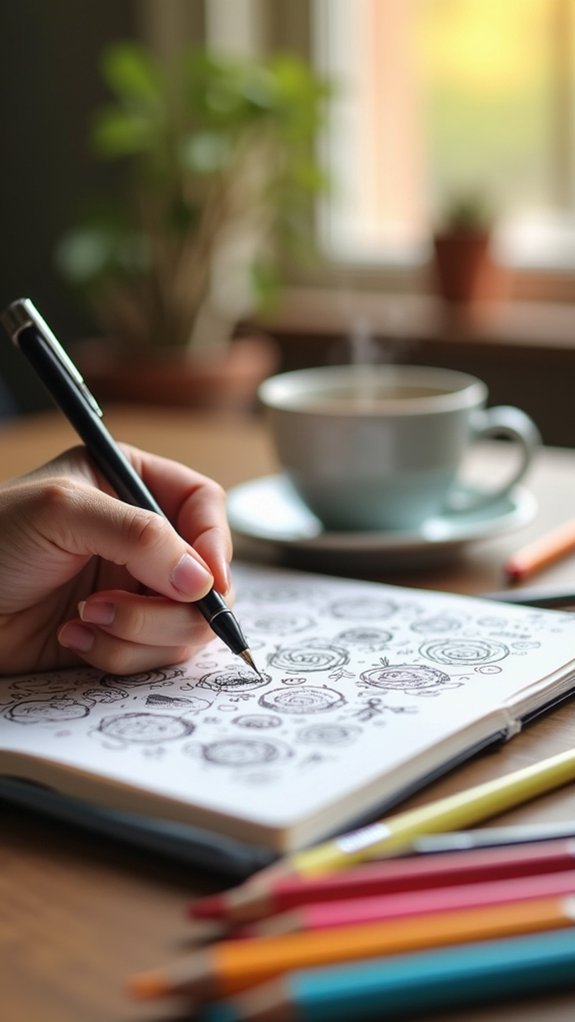
Lots of new doodlers feel the pressure to be perfect, especially after scrolling through amazing artwork online, but embracing some messiness can actually make things more fun.
It helps to compare your doodles only to your past attempts—because the real win is noticing your own progress, even if today’s chicken still looks a little more “blob” than “bird.”
Embracing Imperfection Mindset
Perfectionism can sneak into doodling like an uninvited guest at a party, making people freeze up right when they want to let loose and get creative.
It’s easy to look at a piece of paper, wiggle your pencil, and start worrying that your simple shape isn’t “good enough.”
Here’s a secret: doodling helps you shake off the worry monsters. There are no strict rules—mistakes can actually become the coolest parts of your sketch!
Every doodler, even the pros, started just where you are now. The main goal is to enjoy the process and not let fear of messing up stop you.
Comparing Only to Yourself
Getting comfy with messy lines and funny-looking shapes is a great start, but there’s another big monster that loves to lurk when you’re doodling: the comparison beast.
It sneaks up when you scroll past fancy doodles online, whispering that yours aren’t good enough. Here’s a secret: Your doodles have their own uniqueness, and comparing them only to yourself is the real simple magic trick.
Doodling is supposed to be fun—your weird, wonky lines matter!
- Keep a doodle journal: Track your progress, not perfection. See how your style evolves with each simple practice.
- Set tiny, personal goals: Celebrate drawing two eyes the same size, or just smiling at your results.
- Practice regularly: Even ten messy minutes builds confidence, not comparison. Your journey is yours, and that’s awesome!
Finding Joy in Practice
Sometimes, staring at a blank page can feel like facing down a fire-breathing dragon—everything inside screams, “What if I mess it up?” Doodling anxiety, honestly, can be a real creativity thief, making simple lines seem super serious.
But here’s a secret: practice is way more important than perfection. Doodling is meant to be fun and even a bit therapeutic, letting stress melt away as squiggles and shapes take over. Mistakes? They’re just pit stops along the journey to finding your unique style.
Setting aside a few minutes each day for doodling keeps those creative muscles strong. Start easy—maybe with circles or triangles—then push your imagination from there.
Over time, practice turns those nerves into excitement, making each page a little victory.
Step-by-Step Guide to Drawing Basic Shapes

When learning to doodle, it all starts with just a few basic shapes. Breaking down big ideas into circles, squares, and triangles makes things way less scary—plus, it gives your hand a chance to get comfy.
Now, practicing these shapes over and over might feel a bit like doing jumping jacks for your fingers, but each squiggle counts!
Breaking Down Basic Forms
Shapes—those basic circles, squares, and triangles—are like the secret codes behind every awesome doodle sketch. Mastering basic forms is totally key for releasing your creativity.
Start off simple: sketch these shapes over and over. It might seem boring, but it’s like training for a creativity marathon! Break down drawings by spotting which shapes build them up, and soon you’ll be turning a bunch of lines into anything your brain can imagine.
Here’s a rhythm to follow:
- Start with clear shapes. Draw each basic form—circle, square, triangle—with smooth, confident strokes.
- Combine different shapes. Stack, overlap, or squish them to design new objects or funky characters.
- Spice it up with line thickness and shading. This makes your shapes look fun, bold, and super lively!
Let your creativity run wild!
Practicing Shape Repetition
Jump right in and start filling a page with circles, squares, triangles, and rectangles—the basics every doodle master needs! Practicing these basic shapes may sound simple, but it’s actually the secret sauce to slick doodles.
By repeating each shape again and again, that pencil in your hand becomes like a magic wand, building muscle memory with every line you make. Try drawing your shapes in all sizes—tiny, huge, tilting sideways or standing tall—to keep things interesting and really flex your creativity.
See if you can mix up line thickness or add a little shading for extra pizzazz. Want a real challenge? Start combining shapes and, before you know it, you’re creating anything from smiling robots to quirky cupcakes with serious personality!
How to Sketch Flowers: Carnation, Tulip, and Rose
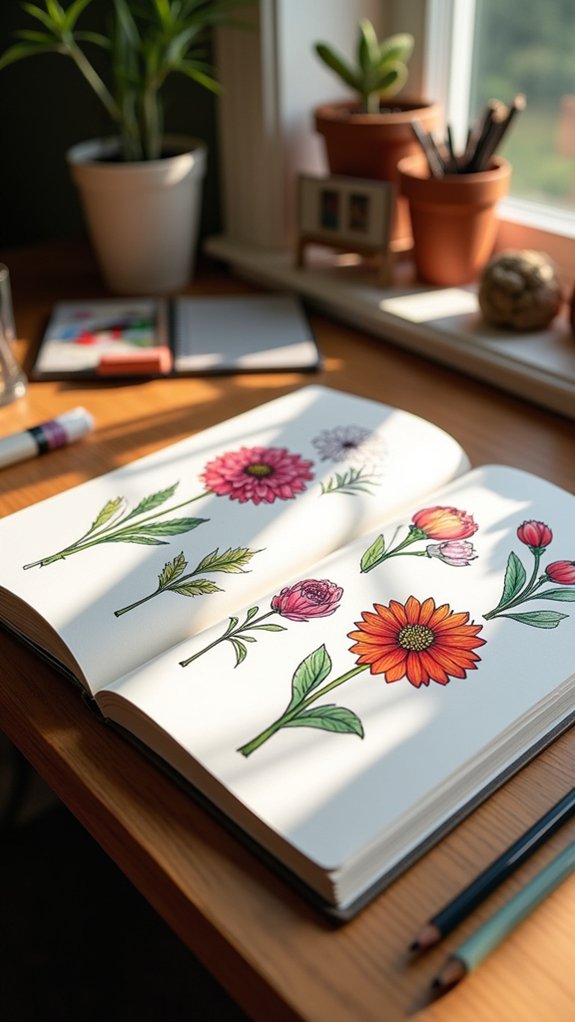
Every flower has its own personality—some look like frilly dresses, while others have petals that curl and spiral in wild directions. Picking up a pencil to sketch a carnation, tulip, or rose isn’t just about drawing lines, it’s about capturing that wild, curly spirit!
Here’s how anyone can get started:
- For a carnation: Begin with an elongated U shape, then layer jagged rectangular petals on top, stacking them in odd numbers for extra fullness—think of a fluffy petticoat.
- When sketching a tulip: Use a U base, overlap three oblong petals, give it a stem, and toss in a couple of leaves for style.
- For a rose: Start with a little spiral, build soft, rounded petals around it, and finish with leaves.
Ink with a fineliner, add color, and practice those flowers!
Fun Everyday Doodles: Coffee, Ice Cream, and Cactus
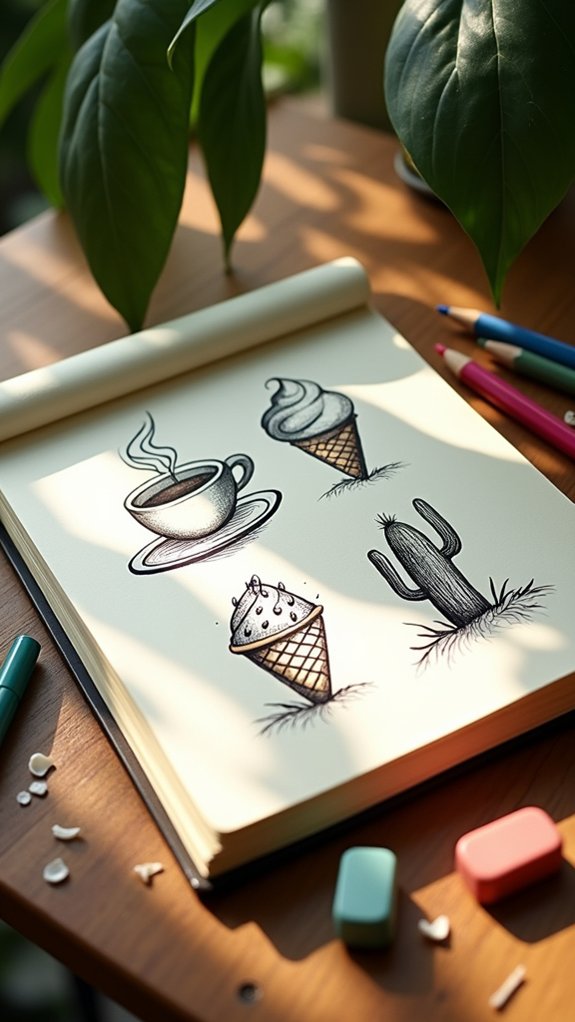
Flowers aren’t the only thing that can add some oomph to your sketchbook—sometimes the most ordinary things make the best doodles! Just think about it: who wouldn’t love a cute ice cream cone, a steamy cup of coffee, or a spiky little cactus chilling on the page?
Start your cup of coffee doodle with a horizontal oval for the rim, add a U for the cup, and don’t forget that awesome handle. For a fun ice cream cone, draw a triangle for the cone, and stack rounded scoops high—maybe add sprinkles or a cherry if you’re feeling fancy.
A cactus? Easy! Try an oval for the body, plus some poky arms. Use bold outlines, thinner details, and splashy Le Plume markers for ultimate wow.
Adding Personality: Doodling Faces and Accessories
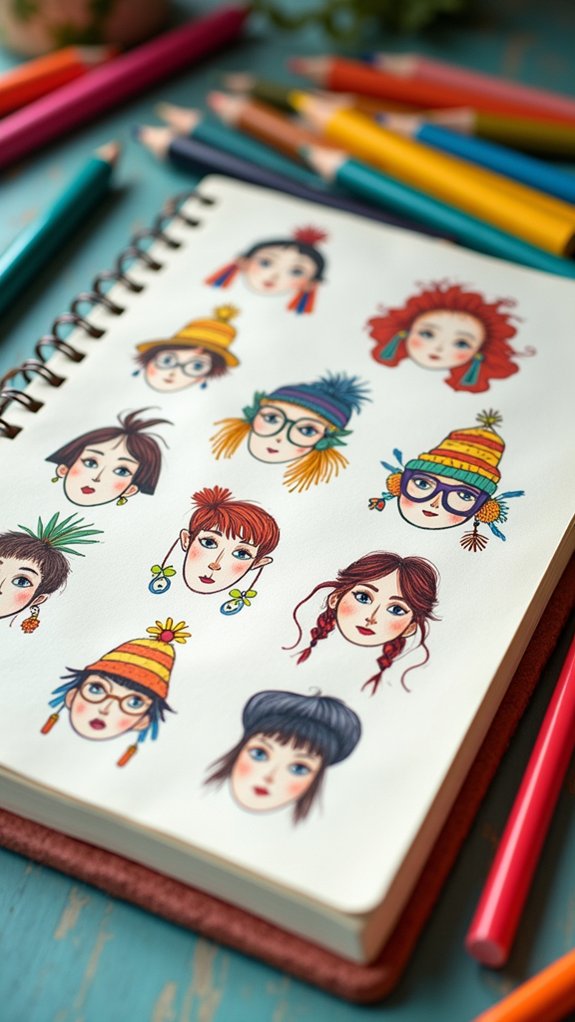
A doodle isn’t just a random squiggle—it can have tons of personality with just a few tiny tweaks.
On one side, I’m going all-in and drawing expressive faces and fun accessories can turn a plain doodle into a mini character!
To get started, most beginners rely on easy shapes and playful details. Here’s a quick breakdown:
- Start with head shapes: Try circles, ovals, or even squares. Each shape gives off a different vibe—one might look super serious, another just plain silly.
- Add features and expressions: Dots for eyes, a line here for the mouth, maybe some wild eyebrows—suddenly your doodle is frowning or laughing!
- Include cool accessories: Sketch in hats, glasses, or scruffy scarves with simple forms, making every character unique!
Simple Seasonal Doodles: Pumpkin, Snowflake, and Snowman
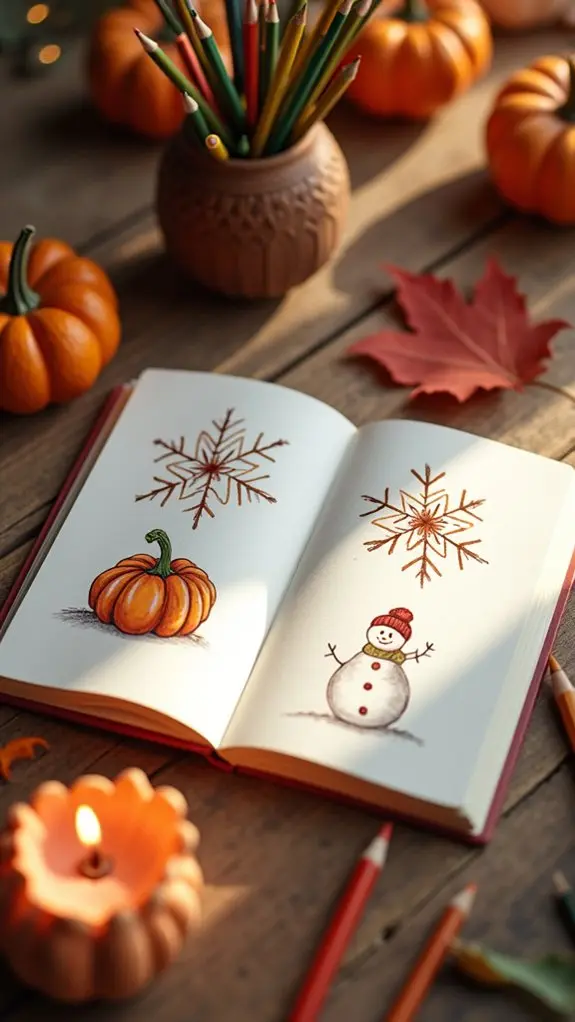
Pumpkins, snowflakes, and snowmen—these seasonal doodles instantly crank up the cozy vibes and bring a little holiday cheer right onto the page.
When it comes to pumpkin doodling techniques, beginners start with a big circle, then add a couple of skinny vertical ovals on each side to make it nice and plump. A quick stem, some curvy lines, and voilà—you’ve got that classic pumpkin look!
For snowflakes, just draw a little hexagon in the center, shoot out six lines like spider legs, and dress up the ends with triangles or diamonds to create cool snowflake patterns.
Snowmen are all about stacking three funny-looking circles, then piling on snowman accessories—a hat, carrot nose, buttons, and maybe even a funky scarf for flair! Add leaves or extra snowflakes for bonus festivity.
Building a Daily Doodle Practice
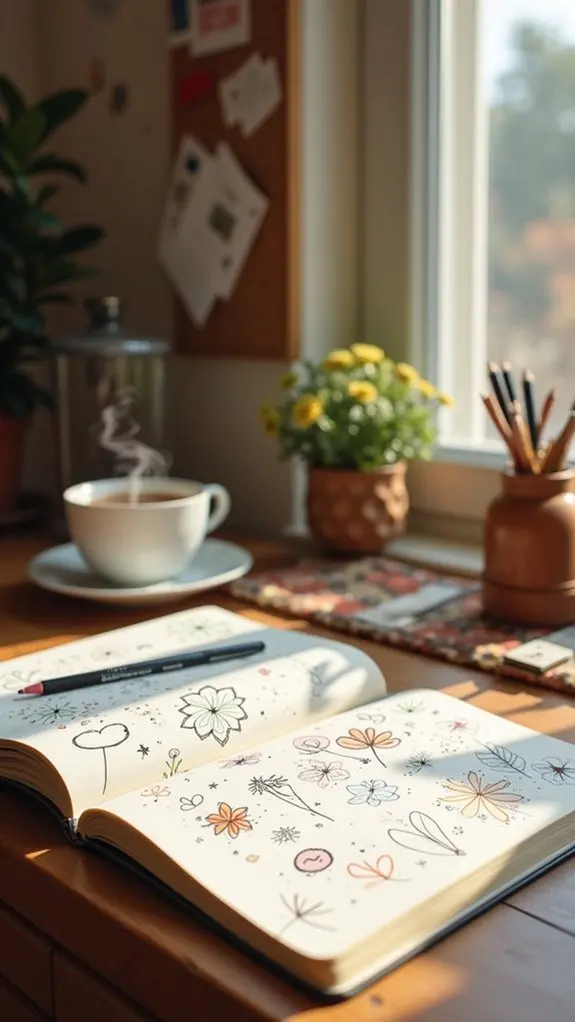
Even if someone’s drawings look like wobbly noodles or squiggly jellybeans at first, turning doodling into a daily habit makes all the difference.
With just 10-15 minutes a day, anyone can build both skills and confidence. A journal full of doodles is like a trophy shelf—each page snickers, “You’re getting better!”
Mixing up supplies, trying out doodle prompts, and jumping into creative exercises keeps things fresh and never boring. For motivation and a friendly challenge, themed challenges can help inspire wild, unexpected ideas.
Here’s how to kick off a daily doodle routine:
- Set a timer and start doodling, no matter what.
- Try new supplies, doodle prompts, and creative exercises.
- Track your progress—let your doodle journal fill with fun.
Creative Ways to Personalize Your Doodles
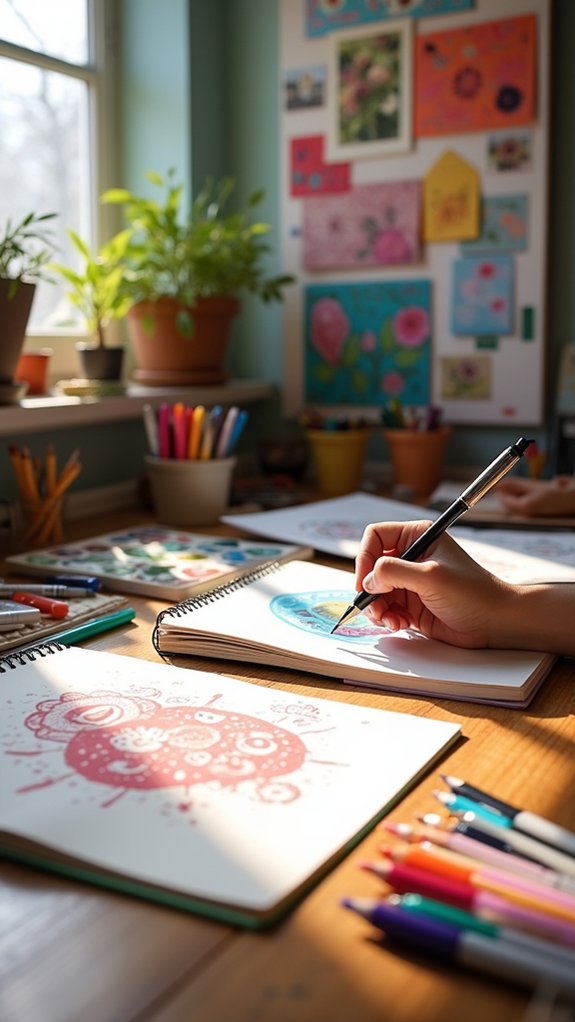
Whether someone’s doodle style is already wild and bold or just starting out wobbly, making each doodle feel uniquely “yours” can be the most exciting part of sketching.
Try playing with doodle patterns—mix stripes, zigzags, polka dots, and even tiny waffles if you’re feeling hungry. Texture adds a ton of personality.
Next, grab some markers and experiment with color blending. Markers like Le Plume Permanent or Le Plume II are perfect for mixing colors that pop or melt together like ice cream on a hot day.
Want to make your sketches one-of-a-kind? Add personalized symbols—maybe your initials, your favorite animal, or a tiny stack of books. You can even doodle around your hobbies, like guitars or sunflowers.
Let your creativity run wild!
Frequently Asked Questions
What Are the Five Styles of Doodling?
The five styles of doodling include abstract doodling, intricate geometric patterns, nature themes, cartoon-inspired works, and character creation. Each style allows unique expression, ranging from structured Zentangle motifs to spontaneous sketch doodling that captures everyday inspiration.
How to Draw a Doodle for Kids?
When drawing a doodle for kids, one should start with simple shapes to build fun characters and objects. Selecting playful doodle themes and encouraging vibrant colors fosters creativity, making the process enjoyable and approachable for young artists.
What Are the Rules of Doodling?
The rules of doodling are minimal, prioritizing creative expression and individual style. Doodling techniques often encourage experimentation, embracing imperfections, and allowing relaxation benefits to emerge naturally without strict guidelines, fostering a stress-free and enjoyable artistic practice for all skill levels.
Is Doodle Art Easy?
Doodle art is generally considered easy, as basic doodle techniques require minimal skill, while various doodle inspirations can be freely explored. The simplicity and accessibility contribute to numerous doodle benefits, including relaxation and enhanced creativity for most individuals.
Conclusion
Doodling isn’t just about drawing random squiggles—it’s about having fun, letting your imagination run wild, and seeing what your hands can create. Anyone can do it, whether your lines are straight or wobbly. Mistakes? They’re just secret design opportunities! Keep practicing, try out new shapes every day, and watch your confidence bloom faster than a doodle rose. Remember, there’s no right or wrong—only your style. So grab that pen and start sketching your way to awesomeness!


Leave a Reply